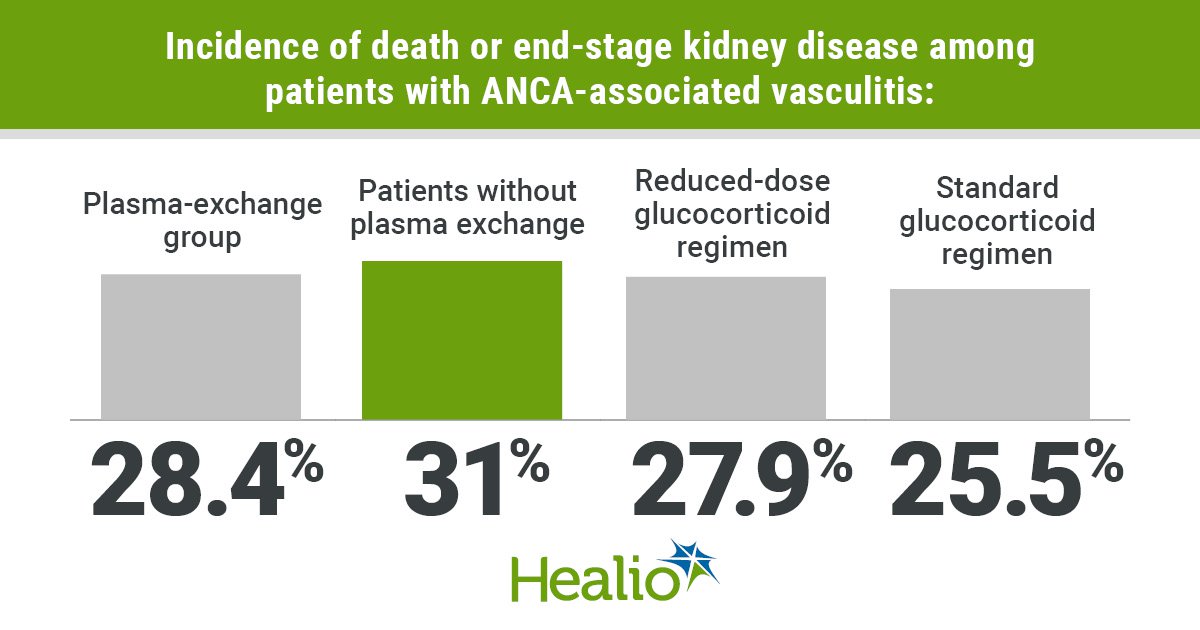Plasma exchange fails to reduce death, end-stage kidney disease in ANCA-associated vasculitis
Plasma exchange did not reduce the incidence of death or end-stage kidney disease among patients with antineutrophil cytoplasmic antibody-associated vasculitis, according to data published in The New England Journal of Medicine.
Researchers also found that, among these patients, a reduced-dose regimen of glucocorticoids was noninferior to a standard-dose plan regarding death or end-stage kidney disease.
“The rapid removal of [antineutrophil cytoplasmic antibodies (ANCAs)] by means of plasma exchange may reduce organ damage from ANCA-associated vasculitis,” Michael Walsh, MD, PhD, of the Population Health Research Institute at McMaster University, in Ontario, Canada, and colleagues wrote. “However, the effect of plasma exchange added to immunosuppressive therapy as compared with immunosuppressive therapy alone on clinically important outcomes, such as death and ESKD, is uncertain.”
“High-dose glucocorticoids were the first treatments found to be effective in ANCA-associated vasculitis, and they remain a cornerstone of disease management,” they added. “However, glucocorticoids have numerous dose-dependent adverse effects, and high-quality data are lacking regarding an effective and relatively safe rate at which glucocorticoid doses can be tapered in patients with ANCA-associated vasculitis.”

Walsh and colleagues conducted the PEXIVAS study to analyze the impact of plasma exchange and two other regimens of oral glucocorticoids on the incidence of death and end-stage kidney disease on patients with ANCA-associated vasculitis. The randomized controlled trial, with a 2-by-2 factorial design, included 704 patients from 16 countries, aged 15 years or older, with new or relapsing granulomatosis with polyangiitis or microscopic polyangiitis. All participants also had a history of positive myeloperoxidase or proteinase 3 antibodies, as well as kidney involvement.
Investigators randomly assigned participants were in a 1:1:1:1 ratio to one of four treatment groups. They assigned 352 to undergo plasma exchange, 352 to receive no plasma exchange, 353 patients to receive a prescription reduced-dose glucocorticoid regimen, and 351 to receive a standard-dose glucocorticoid treatment plan. Participants in the plasma exchange group received seven exchanges within 14 days following randomization. All patients were followed for up to 7 years, with a primary composite outcome of any-cause death or end-stage kidney disease.
According to the researchers, any-cause death or end-stage kidney disease occurred in 28.4% of participants in the plasma-exchange group and in 31% of those in the non-exchange group (HR = 0.86; 95% CI, 0.65-1.13). Further, death from any cause or end-stage kidney disease occurred in 27.9% of participants treated with a reduced-dose glucocorticoid regimen, compared with 25.5% in the standard-dose group, representing an absolute risk difference of 2.3 percentage points (90% CI, –3.4 to 8), which met the criterion for noninferiority.
The researchers also found that serious infections at 1 year were less common among those in the reduced-dose group, compared with the standard-dose group (IRR = 0.69; 95% CI, 0.52-0.93). However, other secondary outcomes were similar in the two groups.
“Our trial in patients with severe ANCA-associated vasculitis showed that plasma exchange did not result in a lower incidence of death or ESKD than no plasma exchange,” Walsh and colleagues wrote. “Reduced exposure to oral glucocorticoids was noninferior to a standard-dose regimen with respect to the risk of death or ESKD and resulted in a lower risk of serious infections in the first year of treatment.” – by Jason Laday
Disclosures: Walsh reports no relevant financial disclosures. Please see the study for all other authors’ relevant financial disclosures.
